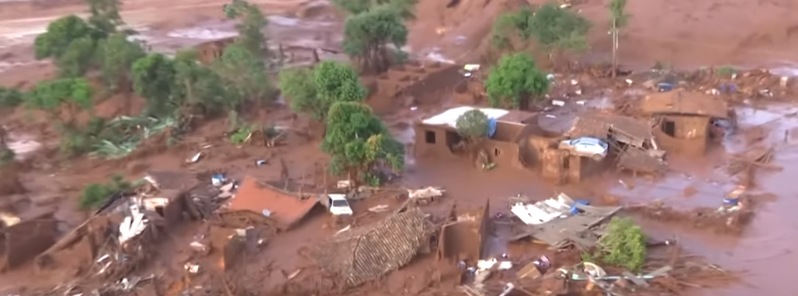Mudslide devastates the village of Bento Rodrigues, Brazil

A mining waste dam in the city of Mariana, Minas Gerais state, Brazil collapsed on the afternoon of November 5, 2015 (local time) unleashing a surge of mud that devastated the nearby village of Bento Rodrigues, population about 600. At this time, it is unknown how many people lost their lives, however, 17 are feared dead and dozens missing.
Residents said no alarms sounded to warn them about the dam break, located about 6.5 km (4 miles) uphill, but they scrambled for higher ground after hearing a deafening burst. Only about 10 of the village's 200 houses were left standing, and cars and other objects were tossed by what survivors described as an eruption of mud. The dam was holding tailings, a mining waste product of metal filings, water and occasionally chemicals, BBC reports.
Although officials have not said what caused the breach, state prosecutor's office said there would be a criminal investigation since no warning alarms went off.

According to IBT, reports of the death toll and injuries from the disaster varied greatly. A spokesman for firefighters in the rescue confirmed with Reuters 30 injuries and at least two deaths, but said the count was likely to rise as more mudslides were possible and rescue efforts continue. Mariana fire chief Adao Severino Junior told AFP news agency more than 50 were injured in southeastern Minas Gerais state and at least 17 people died. Several people were also reported missing.
State fire official Vinicius Teixeira said rescue work is made difficult by the still wet, quicksand-like mud. "Whoever steps on it runs a great risk of sinking and drowning in this mud. There is a risk of bodies not being found," Teixeira said.
The authorities said this was the worst natural disaster in states history and expressed concern that sludge from the burst dam could contaminate the river basin providing water to Belo Horizonte, a city of 2.5 million people in Minas Gerais. However, according to NYT, an official overseeing inspections at the National Department of Minerals Production said the waste was not considered to pose a high risk for pollution as it consisted largely of rocks with tiny amounts of naturally occurring iron ore, rather than chemical waste.
Featured image: Aftermath of a southeastern Brazilian dam collapse. Credit: RT

Sad. More to come unfortunately!